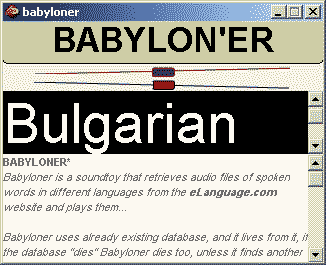 |
Another gem from the ubu list...

From the propaganda:
"Babyloner is a soundtoy that retrieves audio files of spoken words in different languages from the eLanguage.com website and plays them...
Babyloner uses already existing database, and it lives from it, if the database "dies" Babyloner dies too, unless it finds another database...."
There aren't a lot of languages working for it yet -- I know there are Scottish sound files out there -- but a good half-minute of any one of them is plenty. A surprisingly rich if finally annoying earful for a fairly limited program.
I've always been a huge fan of plunderphonics -- this, of course, is not quite that, but in the same general field.
Posted by Brian Stefans at July 22, 2003 11:58 AM | TrackBackThat gives us a pretty good starting point to understand a lot more about variables, and that's what we'll be examining next lesson. Those new variable types I promised last lesson will finally make an appearance, and we'll examine a few concepts that we'll use to organize our data into more meaningful structures, a sort of precursor to the objects that Cocoa works with. And we'll delve a little bit more into the fun things we can do by looking at those ever-present bits in a few new ways.
Posted by: Alice at January 18, 2004 10:03 PMSeth Roby graduated in May of 2003 with a double major in English and Computer Science, the Macintosh part of a three-person Macintosh, Linux, and Windows graduating triumvirate.
Posted by: Edmund at January 18, 2004 10:03 PMA variable leads a simple life, full of activity but quite short (measured in nanoseconds, usually). It all begins when the program finds a variable declaration, and a variable is born into the world of the executing program. There are two possible places where the variable might live, but we will venture into that a little later.
Posted by: Emanuel at January 18, 2004 10:03 PMLet's see an example by converting our favoriteNumber variable from a stack variable to a heap variable. The first thing we'll do is find the project we've been working on and open it up in Project Builder. In the file, we'll start right at the top and work our way down. Under the line:
Posted by: Ursula at January 18, 2004 10:03 PMWe can see an example of this in our code we've written so far. In each function's block, we declare variables that hold our data. When each function ends, the variables within are disposed of, and the space they were using is given back to the computer to use. The variables live in the blocks of conditionals and loops we write, but they don't cascade into functions we call, because those aren't sub-blocks, but different sections of code entirely. Every variable we've written has a well-defined lifetime of one function.
Posted by: Dolora at January 18, 2004 10:03 PM